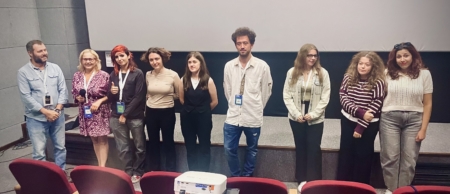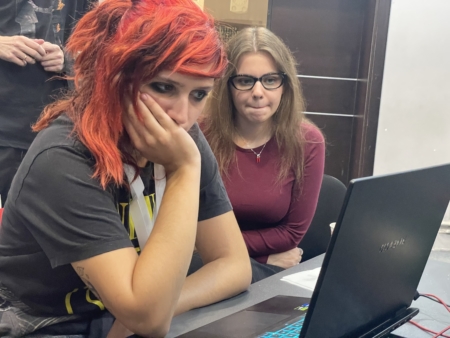The MANAKI Festival: A Space for Discovery and Experimentation with the “Adriatic Network Workshop: Manaki NEXT GENERATION”

This year, the festival organizers offer a workshop aimed at young people to explore and experiment with filmmaking.
This year, seven young individuals from very diverse backgrounds registered for the workshop. Interestingly, the vast majority were women, suggesting a genuine shift may be occurring in this historically gendered industry. Each participant came with a very different background—ranging from complete beginners who had never held a camera to recent graduates of film schools. What united them all was their shared passion for the seventh art.
Guided by two experienced mentors—director Marina Dzidzeva and cinematographer Fejmi Daut—the seven participants (Dunja Sestovic, Ana Marina Nechova, Ardit Muhaxhiri, Ksenija Keni Mano, Kornelija Josifova, Katerina Dimovska, and Branka Josifovska) split into two teams to write, direct, and edit one film per group in just three days.
A considerable challenge, especially given the very limited resources:
The first film (Before and After the Light) was shot on a Sony FX3 with a single 35mm anamorphic lens.This choice of a fixed focal length was a deliberate one, intended to recreate the shooting conditions of early cinema:
“I really love this fixed focal length, because it mimics more the eye and it’s closer to the vision or maybe the past time that didn’t have so much lenses,” explains Ardit, who served as cinematographer for both films. He also pointed out how accessible filmmaking has become today: cameras like these are inexpensive and within reach for almost anyone (the second film was shot with a Canon EOS 1DX Mark III).
For lighting, the teams mostly used available city lights, supplemented by one or two small LED sources. This approach was also inspired by one of the two themes proposed for this year’s workshop: Light Pollution. Thanks to the capabilities of modern cameras, they were able to capture high-quality images without additional lighting:
“We only had like two little lights. They have so much ISO, some sensitivity, and we shot a scene at 51,000 ISO with the city light only.”
The second creative inspiration offered by the mentors was the story of the Manaki brothers, cinema pioneers in the Balkans who made the region’s first films in Bitola in 1905. Using the brothers’ history as a foundation, the participants created short narratives reminiscent of episodes from their lives:
“Well, I think that what’s pretty visible in our movie is that it is based on Yanaki’s prison time. So in our movie, we have a modern version of Milton visiting Yanaki and Yanaki points out that he has the stars in his cell. Milton becomes much more aware and he starts to realise how much he’s surrounded by artificial lighting that he doesn’t need. As we presently were after the workshop.”
Deeply impressed by the atmosphere of the city of Bitola, the participants enjoyed exploring its hidden corners to find their shooting locations. At the same time, they became acutely aware of the extent of modern light usage—especially in the city center, where a large portion of it is unnecessary and prevents us from seeing the sky above our heads.
This week of workshops proved to be rich in learning for the participants, who shared the key lesson they took away:
“That we need to make compromises, that you cannot just take one idea and then stick to it, because when you work in a group, everybody has creative input and everybody has their own ideas, so you need to learn how to take, for example, three ideas and then put it into one and to be able to make that work together. I think that’s the art of these kinds of workshops.”
Workshops like this one are a real opportunity offered by the festival’s organizers for aspiring filmmakers to discover all the stages of making a film in a very short time. Guided throughout by their two mentors, the young participants wished to express their gratitude to them and to the festival:
“We’re really grateful to have mentors like Mari and Fejmi, who are really experienced and were available for all of our questions. They were present with us while shooting and gave us suggestions and ideas. Yeah, they took care of us basically as their children during this workshop.”

The two films already show great creativity and very promising technical choices! We can’t wait to see what the next workshop participants will create for the 2026 edition of the festival!
Links to both films



